MSc Management Leading through Digital Disruption Assignment Sample 2023
Introduction
Digital disruption is an inevitable part of modern world as all businesses and industries are striving to achieve improvement in their performance through the help of digital measures. Digital disruption refers to a change that modifies behaviours and expectations within industries, markets, cultures and processes by means of digital channels and capabilities (Skog et al. 2018).
The report is about leading process thorough aspects of digital disruption and it highlights processes of adopting this disruption and how a company in UK improved their performance by being “Digital ready”. Entire discussion is going to pivot around Astrazeneca, a renowned UK company.
Task 1: The Case for Change

Figure 1: Working aspects of Astrazeneca
(Source: ASTRAZENECA, 2022)
Astrazeneca is a renowned UK based company headquartered in Cambridge, UK. This is a “British-Swedish multinational biotechnology and Pharmaceutical Company”. Astrazeneca serves whole world with their medical products and medicines. US$37.417 billion and roughly around 76,100 are their total revenue and number of workers respectively, by year 2021 (ASTRAZENECA, 2022). During period of COVID-19, this company was engaged in development of “COVID-19 vaccine”.

Figure 2: Connectivity of Astrazeneca
(Source: ASTRAZENECA, 2022)
The mentioned company manufactures pharmaceutical products which include diseases related to cardiovascular, inflammation, respiratory, oncology and to name a few (ASTRAZENECA, 2022). All countries in whole world are provided with different medical products, medicines, pharmaceuticals devices and other medicine related goods by this company.
As per statement of Mallapaty and Callaway, (2021), by inventing COVID-19 vaccine, this company took a great deal in dealing with this pandemic. They have supported many countries by providing vaccines in this period and this was a significant step which would be remembered by whole world.

Figure 3: Revenue of Astrazeneca
(Source: ASTRAZENECA, 2022)
Digital transformation and disruption are some indispensable parts of Astrazewneca’s activities. Process of decision making, increasing awareness among consumers & employees and rapid implementation of modified planning are executed by digital disruption.
In process of delivering life saving medicines to different countries and people in need, they have witnessed incorporation of digital improvement and have channelized it with health. COVID Pandemic and innovation of E-commerce platforms are some of reasons behind incorporation of digital disruption by Astrazeneca.
Technological disruption was executed by this company in an efficient way. Technological advancements, adopting improved digital measures, modifying business planning or activities, modification in customer relation, analysis of market demands and developing internal infrastructure are some of factors associated with digital disruption of Astrazeneca (ASTRAZENECA, 2022).
COVID-19 negatively impacted almost all types of industries and companies around globe. In this period, demands of medicines and medical products were in high demand. Scarcity of specific medicines needed to heal COVID could be seen in many medicine shops and hospitals.
Astrazeneca, instead of being affected by this pandemic, adopted digital advancements like “E-commerce Platform” to serve people across globe. Through this E-Commerce platform, named “AstraZeneca Innovation Marketplace (AIM)”, they execute research before diagnosis of any disease. This platform helps them facilitate research process and lessen research timeframe by automating administrative and legal measures (NORDICLIFESCIENCE, 2022).
This is an important digital disruption adopted by Astrazeneca which facilitated medical service and purchase of pharmaceutical goods through an online platform. Several specific objectives are achieved by inculcating technological disruption.
Astrazeneca, has enhanced their business performance, developed new business models, increased efficiency of their workers and made business agile by help of digital transformation. In this way, they have gained enough competitive advantage over other multiple pharmaceutical companies.
Task 2: Gaining Digital Business Agility
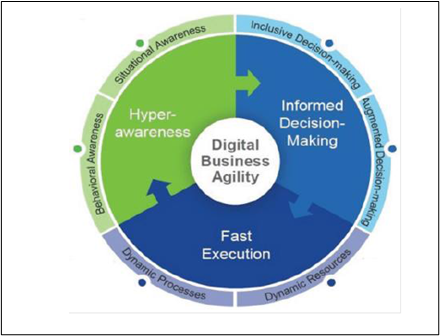
Figure 4: Digital Agility Model
(Source: As inspired by Setiawan, 2018)
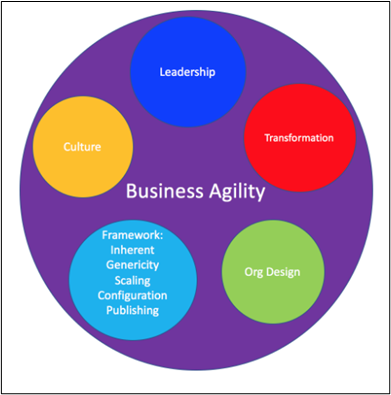
Figure 5: Business agility
(Source: Inspired by Nwaiwu, 2018)
The Digital Business agility model consists of three broad parts which are awareness of digital disruption, informing decisions to others and implementing new planning. As per suggestion of Setiawan, (2018), adopting digital agility model is necessary in developing business performance in context of any sort of company or industry.
The first stage depicts awareness which refers to an understanding of need for change. In this stage, employees and other workers in an organisation address several issues and understand requirement of change. Similarly, Astrazeneca noticed several issues during COVID-19 period.
As a result, they felt a need to adopt some change in their business pattern. Second stage of Digital Business agility model is about informing workers about changes. In this stage, modified planning and measures are conveyed to employees so that they can become ready to get accustomed to those changes.
In this way, all workers and employees can accept that change and take part in this process. Through this, facilitation of improvement within an institution or business becomes easy.
Astrazeneca, a result of digital disruption has adopted an E-commerce platform. In this way, they ensured availability of numerous pharmaceutical products to their consumers all over world. As per statement of Nwaiwu, (2018), informing change within an organisation enhances transparency and efficiency among workers.
After employees get to know what changes are going to take place, they can participate spontaneously in this process. This stage reduces the chance of confusion and discrepancies occurring among employees and other personnel of an organisation. Through this stage, Astrazeneca conveyed new measures to their workers and trained them to utilise their E-commerce platform. In third stage, main focus is to implement modified decisions.
As per suggestions of BONGSO and HARTOYO, (2022), implementation of change is an essential part of any company in order to achieve their objective in an effective way. Modified plans and improved structure are implemented by Authority of Astrazeneca through this stage. They developed an E-commerce platform to reach more numbers of consumers and provide them with improved medical products and medicines.
Leadership ability can be developed, numerous productive transformations take place, modified designing of business structure gets implemented and change in business culture can be observed through utilising this “Business Agility Model”.
Artificial intelligence has been used by Astrazeneca to serve more consumers and run their ecommerce platform. As a recommendation, it can be mentioned that by using advanced databases and software, they would be able to manage and access their important data.
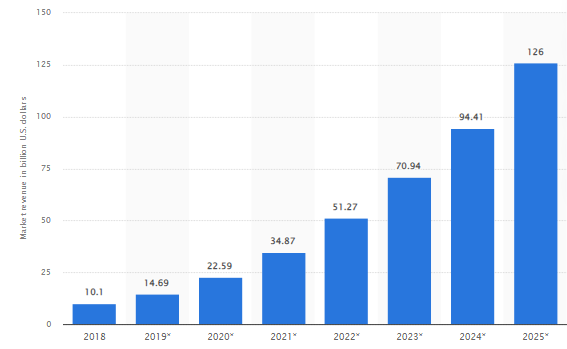
Figure 5: Use of AI helps in increasing revenue of companies
(Source: Thormundsson, 2022)
From this statistical report of 2022, it can be noted that use of AI has helped organisations to gain profitability. Through the help of artificial intelligence, robotic process automation along with machine learning, it is expected to usage would ascend to 126 billion by 2025 (Thormundsson, 2022).
In this manner, it can be recommended to Astrazeneca that usage of improved “Machine learning” process to notice requirements of change, as per first stage of digital agility model. In second stage, they can use augmented reality for conveying that message of modified planning to their employees. Regarding third stage if this model, they can use advanced databases like Blockchain to implement that proposed change and keep track of that.
Task 3: Create a Digital Ready Culture
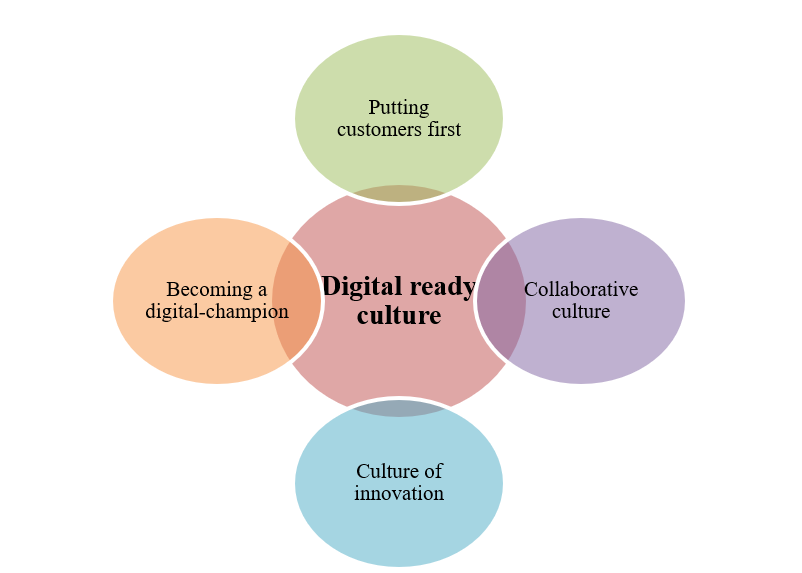
Figure 6: Digital Ready Culture
(Source: As inspired by Zaripova, 2021)
A “digital ready culture” refers to infrastructures of companies through which they are able to undertake any change when needed. As per statement of Zaripova, (2021), digitization has facilitated business performance and resolved multiple issues of human life.
Activities including manufacturing, promoting advertisements, providing consumers with services or products, applying for funding to investors and executing daily business works are done by taking help of technological advancements. Astrazeneca, the UK based pharmaceutical company, has adopted improved technological measures to cope with multiple issues and develop their business performance.
Speed of business activities, bridging productive impact, acceptability of improved technological disruption and autonomous behaviour are some broad characteristics of a technology ready culture within a company. As opined by SMITH, (2021), being digitally ready refers to a sense of acceptability towards advanced technical measures from side of a business. Through this, goals and objectives of a business are achieved in a competent way.
As per “Think with Google (2017)”, though adopting benefits of digital marketing strategies along with incorporating artificial intelligence, machine learning and automation technologies, any company can make progress in their performance. A huge amount of consumers can be reached with help of various online platforms and on other hand; consumers also get benefitted by these measures.
In this discussion about Astrazeneca, they can communicate with their consumers and collaborate with other companies through channels of “augmented reality”. They can manage and keep their important data saved in “improved digital databases” like Blockchain. They need to increase their promotion through advertising in different digital platforms and social media to get more consumers.
Regarding online platforms, they already have developed an E-commerce platform to serve more people from their location. There are several specific ways in which Astrazeneca can cherish a digital ready culture within their company which are as followed.
Putting customers first
Consumers are to be the most important factor for Astrazeneca as they are truly committed to serve people all over world. Through E-commerce platforms, multiple other online platforms and through using artificial intelligence, they can move forward to achieve their goals in less time (Obogo et al. 2021).
Creating a collaborative culture
Collaborating with other businesses brings about an effective way to improve performance of any company. As per statement of Schmidt et al. (2018), collaborating with others facilitates smooth functioning of businesses and ensures growth of all involved companies. According to this, Astrazeneca can consider working with other companies to improve their performance.
Instilling a culture of innovation
Acceptability of digital transformation is very essential for Astrazeneca to improve their work pattern. As per opinion of Wang et al. (2021), incorporating a culture related to new innovation develops business performance. The mentioned company needs to implement more advanced technology to manage their huge amount of responsibility.
Becoming a digital-champion
Through implementing various improved technologies within business work frame, Astrazeneca can secure a best position over other pharmaceutical companies across the world. Incorporating numerous digital measures, this company can become the “digital champion” which eventually would enhance success for them (Casselden and Dawson, 2019).
Task 4: Steer Collaboration
Collaboration is very important for any business to improve performance. As per statement of Audretsch and Belitski, (2020), collaboration across numerous geographical locations enhances versatility of a business patter and they get introduced to different business strategies and thus modify their own activities.
Productivity of workers is encouraged by this and it opens an opportunity for them to learn from others. As suggested by Rezaei and Kamali, (2022), potential and efficiency of implementing any kind of change in an organisation gets accelerated by collaboration activities. Astrazeneca operates throughout the whole world and collaboration is an important part of their performance.
Astrazeneca is planning to develop a new position within their organisation which is “The Chief Collaboration Officer (CCO)”. They have taken this step in order to increase transparency within their organization and break unwillingness of sharing information between teams and different distinct departments.
Sharing information is very much needed in an organization as it enhances trust among workers and thus boosts their dedication towards company (Krasnokutska et al. 2019). Through this decision they would surely be able to reduce confusion and conflicts among their employees.
There are several roles and responsibilities of a CCO. They are responsible for managing whole administration and coordination process within a company and evaluating its needs. Business planning, recruiting staff, managing process of fundraising, execution of different projects and overall development of business is dependent on performance of CCO (HBR, 2022).
Roles and responsibilities of CCO of Astrazeneca would include bringing about overall solution of collaboration, involving different strategies regarding this, service development, facilitating sales, managing HR activities and engaging improved technology within company. “Governments of different countries”, “academia”, “scientific organizations”, “biotech companies”, “Peer companies” and “patient groups” are some departments Astrazeneca works in collaboration with (ASTRAZENECA, 2022).
Through these collaborations they strive to utilise advanced technology and scientific innovation and facilitate delivery of medicines to their target audience. The proposed CCO would be accelerating these activities in a more efficient way. In-licensing collaborations with academia, peer companies and biotech, done by this company, help them to improve their portfolio of business performance.
CCO would be managing divestment of several medicines and process of out-licensing to enhance value of their assets and thus they would ensure availability of medicines for patients. Product collaboration is another essential part which is to be handled by CCO and through this they would be able to provide medicines to many more patients outside their own areas.
CCO of Astrazeneca needs to address issues in process of collaboration and immediately resolve them. Requirement of collocation of this company is to be evaluated by their CCO collaborations needs to be done in an efficient way so that performance of Astrazeneca gets better. New innovations and improved technological disruption are to be incorporated within collaboration process managed by CCO.
Task 5: Selecting Leaders
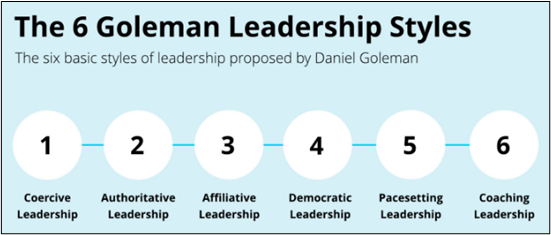
Figure 7: Goleman’s leadership Styles
(Source: Inspired by Budhathoki, 2019)
Leadership is an important aspect of any company to run their business smoothly and effectively. According to Budhathoki, (2019), there are 6 broad types of leadership styles which were defined by Daniel Goleman, those are “Coercive”, “Authoritative”, “Affiliative”, “Democratic”, “Pacesetting” and “Coaching” leadership. Coercive leadership depicts a style in which a leader gets work done by team members by forcing them without considering their will.
Sometimes, this kind of leadership is effective to complete specific important tasks by unwilling employees (Eivazzadeh and Nadiri, 2022). Authoritative leadership, on other hand, refers to a specific style in which leaders themselves set objectives, make decisions and decide the whole process of executing work.
According to Zabolotniaia et al. (2019), through this leadership, leaders do not involve workers in decision making process. Affiliative leadership represents a particular leadership style in which leaders try to maintain a harmony among workers and thus resolve any issue together. This type is beneficial to develop trust among workers towards their leader and conflicts can be solved easily (Thoha and Avandana, 2020).
Democratic style is focused on active participation of all members in the decision mankind process. According to FAKHRI et al. (2021), this specific type of leadership can be applied in any kind of industry to improve work environment. Pacesetting style speaks of leaders who set a high target of work for both him/herself and for workers.
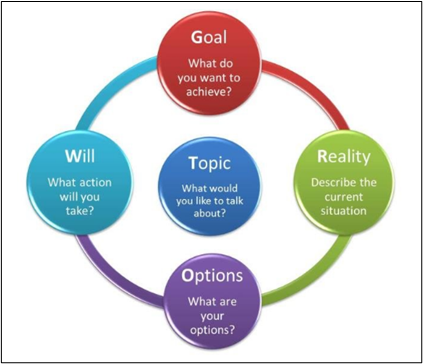
Figure 8: The Grow Model
(Source: Inspired by Grant, 2022)
Leaders, in this style, expect all workers to reach their target within a given time frame (Vasilescu, 2019). The final type in this discussion is Coaching style which refers to certain styles in which leaders identify strengths and weaknesses of theme members and therefore motivate them to improve.
This type of leadership is highly desirable in companies to develop their business performance (Karlsen and Berg, 2020). These were 6 broad leadership styles mentioned by Goleman which are followed by companies regarding their needs and requirements.
Astrazeneca, can adapt “Coaching leadership” along with incorporating digital transformation to improve their performance. Through this style, leaders of this company need to observe strengths and weaknesses of their workers and motivate them to improve their weak sides. Accepting digital innovation and improved technology is to be done by Authority of Astrazeneca.
This can be possible only if they can improve workability of their employees by motivating them. The way in which leaders of this company would be achieving this goal can be explained by “Grow Model”. As opined by Grant, (2022), there are 4 major elements through which any effective coaching process can be done in organizations, which are, “Goal”, “Reality”, “Option” and “Will”. Astrazeneca, through setting their goal, would be setting specific objectives to achieve.
As per second element, leaders of this company would be identifying their current situation or reality so that they can understand the requirement of incorporating digital transformation. After that, they need to find several options for implementing change.
Adopting improved technology in their daily activities can be a good option in this case. Finally, the will of their employees, motivated by leaders, is essential for executing process of change. Therefore, in this way, Astarzeneca would be able to deserve more consumers and improve their work pattern.
Conclusion
This report highlights significance of digital disruption in companies and how they can expand their business by adopting advanced technological measures. The entire discussion has been done on a renowned UK based pharmaceutical company Astrazeneca. Therefore, it can be concluded that digital transformation is very essential for improvement of any business or industry across the whole world.
Assessment Self-Evaluation
This whole report is divided into 5 important parts. From part 1, I got to know about several reasons for which Astrazeneca has incorporated digital disruption within their activities. In Part 2, I have tried to recommend a few digital technologies and initiatives which can be accepted by Astrazeneca. In part 3, I have given some suggestions by which this company can become “Digital-ready” which is very required in modern world.
Knowledge from existing information regarding this topic in articles and databases helped me formulate these recommendations. In part 4, I have learned about a new position, the “CCO”, which is going to be developed by Astrazeneca. In the last part, I have learnt about several types of leaderships and have recommended one specific type for Astrazeneca.
References
ASTRAZENECA (2022). “Collaboration: central to our success”. Available on: https://www.astrazeneca.com/content/dam/az/Partnering/Partnering_with_AstraZeneca.pdf. [Accessed on: 20th August, 2022]
ASTRAZENECA (2022). “Digital Health”. Available on: https://www.astrazeneca.com/r-d/digital-health-revolutionising-healthcare-for-patients.html. [Accessed on: 20th August, 2022]
ASTRAZENECA (2022). “Full year and Q4 2021 results”. Available on: https://www.astrazeneca.com/content/dam/az/PDF/2021/full-year/Full-year-2021-results-announcement.pdf [Accessed on: 1st September, 2022]
ASTRAZENECA (2022). “Official Website”. Available on: https://www.astrazeneca.com/. [Accessed on: 20th August, 2022]
Audretsch, D.B. and Belitski, M., (2020). The limits to collaboration across four of the most innovative UK industries. British Journal of Management, 31(4), pp.830-855.
BONGSO, G. and HARTOYO, R., (2022). The Urgency of Business Agility During COVID-19 Pandemic: Distribution of Small and Medium Business Products and Services. Journal of Distribution Science, 20(6), pp.57-66.
Budhathoki, K., (2019). Does Leadership Style Matter for Enhancing Economic Performance?. Economic Journal of Nepal, 42(1-2), pp.55-72.
Casselden, B. and Dawson, L., (2019). Feeling connected: qualitative analysis of social and digital inclusion experienced by digital champion volunteers at Newcastle City library. Voluntary Sector Review, 10(3), pp.371-385.
Eivazzadeh, N. and Nadiri, H., (2022). An empirical study to investigate the coercive management behavior: Evidence from Academia.
Evanschitzky, H., Bartikowski, B., Baines, T., Blut, M., Brock, C., Kleinlercher, K., Naik, P., Petit, O., Rudolph, T., Spence, C. and Velasco, C., (2020). Digital disruption in retailing and beyond. Journal of Service Management Research, 4(4).
FAKHRI, M., SYARIFUDDIN, S., WINARNO, A., NURNIDA, I. and HANUM, S., (2021). Democratic leadership practice to construct clan organizational culture in family companies. The Journal of Asian Finance, Economics and Business, 8(1), pp.803-811.
Grant, A.M., (2022). Is it time to REGROW the GROW model? Issues related to teaching coaching session structures. Coaching Practiced, pp.29-40.
HBR (2022). “Who Should be Your Chief Collaboration Officer?”. Available on: https://hbr.org/2010/10/who-should-be-your-chief-colla. [Accessed on: 20th August, 2022]
Karlsen, J.T. and Berg, M.E., (2020). Coaching leadership style: a learning process. Int. J. Knowl. Learn., 13(4), pp.356-368.
Krasnokutska, N., Kruhlova, O., Kozub, V. and Martíšková, P., (2019). Transparency of the enterprise: from theory to practice of evaluation (on the example of retail networks).
Mallapaty, S. and Callaway, E., (2021). What scientists do and don’t know about the Oxford-AstraZeneca COVID vaccine. Nature, 592(7852), pp.15-17.
NORDICLIFESCIENCE (2022). “AZ Adopts e-Commerce Platform”. Available at: https://nordiclifescience.org/astra-adopts-e-commerce-platform/. [Accessed on: 20th August, 2022]
Nwaiwu, F., (2018). Review and comparison of conceptual frameworks on digital business transformation. Journal of Competitiveness.
Obogo, J.U. and Adedoyin, F.F., (2021), September. Data-Driven Business Analytics for the Tourism Industry in the UK: A Machine Learning Experiment Post-COVID. In 2021 IEEE 23rd Conference on Business Informatics (CBI) (Vol. 2, pp. 78-86). IEEE.
Rezaei, A. and Kamali, A.R., (2022). Analysis of collaboration between AstraZeneca and the higher education sector in the UK. Industry and Higher Education, p.09504222221086520.
Schmidt, J., Drews, P. and Schirmer, I., (2018). Charting the emerging business ecosystem of fintechs and banks: Seven types of collaborative business models.
Setiawan, B., (2018). A Critical Review of the Business Agility Literature in the Advancement of Information and Communication Technology.
Skog, D.A., Wimelius, H. and Sandberg, J., (2018). Digital disruption. Business & Information Systems Engineering, 60(5), pp.431-437.
SMITH, R.R., (2021). Building digital-ready culture.
Thoha, N. and Avandana, I.M.N.W., (2020). Project Managers’ Leadership Styles and Their Effects on Project Management Performance. Pertanika Journal of Social Sciences & Humanities, 28(2).
Thormundsson, G., (2022). “Revenues from the artificial intelligence (AI) software market worldwide from 2018 to 2025”. Available on: https://www.statista.com/statistics/607716/worldwide-artificial-intelligence-market-revenues/ [Accessed on: 2nd September, 2022]
Vasilescu, M., (2019). Leadership styles and theories in an effective management activity. Annals-Economy Series, 4, pp.47-52.
Wang, Y., Farag, H. and Ahmad, W., (2021). Corporate culture and innovation: A tale from an emerging market. British Journal of Management, 32(4), pp.1121-1140.
Zabolotniaia, M., Cheng, Z. and Dacko-Pikiewicz, Z., (2019). Influence of leadership style on employees’ innovative activity. Polish Journal of Management Studies, 20.
Zaripova, D.A., (2021), December. The importance of modern educational technology in the digital society. In International journal of conference series on education and social sciences (Online) (Vol. 1, No. 2).

